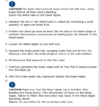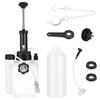Preparing to do a brake bleed on the car.
Seems simple enough. This is the official workshop guide:

This is exactly what I expected.
However, I came across a few guides online that say you have to be careful with the pumping the break method and that a gravity bleed is better:
" Doing this with the bleeder open means the pedal will go all the way to the floor and this means the master cylinder piston seals are pushed all the way to the end of the bore in the cylinder. Old vehicles, where there may be lots of debris/corrosion etc along the unswept section of the bore, could damage the seals on the piston. This will make for loss of braking pressure when using the car from then on. A rebuild kit will be necessary to correct. Gravity bleeds avoid this risk"
Is this a valid concern? Especially for an 18 year old car?
Seems simple enough. This is the official workshop guide:

This is exactly what I expected.
However, I came across a few guides online that say you have to be careful with the pumping the break method and that a gravity bleed is better:
" Doing this with the bleeder open means the pedal will go all the way to the floor and this means the master cylinder piston seals are pushed all the way to the end of the bore in the cylinder. Old vehicles, where there may be lots of debris/corrosion etc along the unswept section of the bore, could damage the seals on the piston. This will make for loss of braking pressure when using the car from then on. A rebuild kit will be necessary to correct. Gravity bleeds avoid this risk"
Is this a valid concern? Especially for an 18 year old car?


